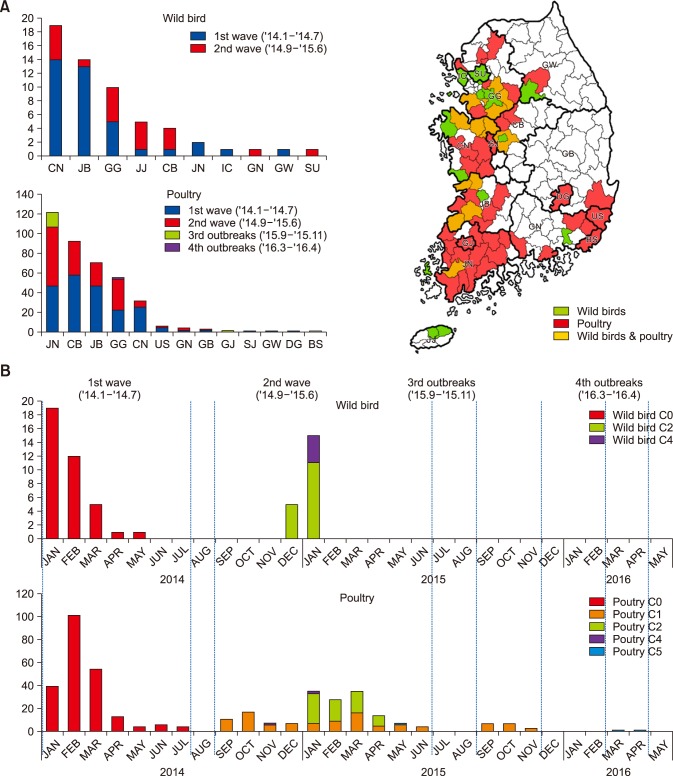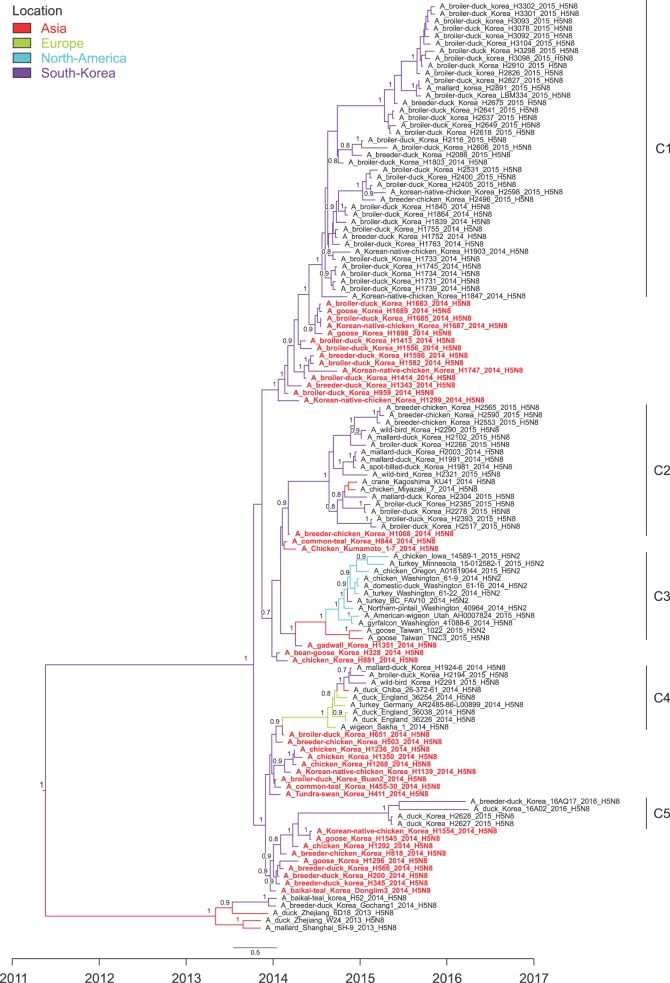J Vet Sci.
2017 Mar;18(1):89-94. 10.4142/jvs.2017.18.1.89.
Phylogeographical characterization of H5N8 viruses isolated from poultry and wild birds during 2014–2016 in South Korea
- Affiliations
-
- 1Avian Disease Research Division, Animal and Plant Quarantine Agency, Gimcheon 39660, Korea. leeyj700@korea.kr
- KMID: 2412592
- DOI: http://doi.org/10.4142/jvs.2017.18.1.89
Abstract
- During 2014-2016 HPAI outbreak in South Korea, H5N8 viruses have been mostly isolated in western areas of the country, which provide wintering habitats for wild birds and have a high density of poultry. Analysis of a total of 101 Korean isolates revealed that primitive H5N8 viruses (C0 group) have evolved into multiple genetic subgroups appearing from various epidemiological sources, namely, the viruses circulating in poultry farms (C1 and C5) and those reintroduced by migratory birds in late 2014 (C2 and C4). No C3 groups were detected. The results may explain the possible reasons of the recent long-term persistence of H5N8 viruses in South Korea, and help to develop the effective measures in controlling HPAI viruses.
MeSH Terms
Figure
Cited by 2 articles
-
Evolution, global spread, and pathogenicity of highly pathogenic avian influenza H5Nx clade 2.3.4.4
Dong-Hun Lee, Kateri Bertran, Jung-Hoon Kwon, David E. Swayne
J Vet Sci. 2017;18(S1):269-280. doi: 10.4142/jvs.2017.18.S1.269.Recent outbreaks of highly pathogenic avian influenza viruses in South Korea
Hye Kwon Kim, Dae Gwin Jeong, Sun-Woo Yoon
Clin Exp Vaccine Res. 2017;6(2):95-103. doi: 10.7774/cevr.2017.6.2.95.
Reference
-
1. Alexander DJ. A review of avian influenza in different bird species. Vet Microbiol. 2000; 74:3–13. PMID: 10799774.
Article2. Hill SC, Lee YJ, Song BM, Kang HM, Lee EK, Hanna A, Gilbert M, Brown IH, Pybus OG. Wild waterfowl migration and domestic duck density shape the epidemiology of highly pathogenic H5N8 influenza in the Republic of Korea. Infect Genet Evol. 2015; 34:267–277. PMID: 26079277.
Article3. Hoffmann E, Stech J, Guan Y, Webster RG, Perez DR. Universal primer set for the full-length amplification of all influenza A viruses. Arch Virol. 2001; 146:2275–2289. PMID: 11811679.
Article4. Jeong J, Kang HM, Lee EK, Song BM, Kwon YK, Kim HR, Choi KS, Kim JY, Lee HJ, Moon OK, Jeong W, Choi J, Baek JH, Joo YS, Park YH, Lee HS, Lee YJ. Highly pathogenic avian influenza virus (H5N8) in domestic poultry and its relationship with migratory birds in South Korea during 2014. Vet Microbiol. 2014; 173:249–257. PMID: 25192767.
Article5. Kang HM, Lee EK, Song BM, Jeong J, Choi JG, Jeong J, Moon OK, Yoon H, Cho Y, Kang YM, Lee HS, Lee YJ. Novel reassortant influenza A(H5N8) viruses among inoculated domestic and wild ducks, South Korea, 2014. Emerg Infect Dis. 2015; 21:298–304. PMID: 25625281.
Article6. Kaplan BS, Russier M, Jeevan T, Marathe B, Govorkova EA, Russell CJ, Kim-Torchetti M, Choi YK, Brown I, Saito T, Stallknecht DE, Krauss S, Webby RJ. Novel highly pathogenic avian A(H5N2) and A(H5N8) influenza viruses of clade 2.3.4.4 from North America have limited capacity for replication and transmission in mammals. mSphere. 2016; 1:e00003–e00016. PMID: 27303732.
Article7. Kim HR, Lee YJ, Park CK, Oem JK, Lee OS, Kang HM, Choi JG, Bae YC. Highly pathogenic avian influenza (H5N1) outbreaks in wild birds and poultry, South Korea. Emerg Infect Dis. 2012; 18:480–483. PMID: 22377052.
Article8. Kim HR, Park CK, Lee YJ, Woo GH, Lee KK, Oem JK, Kim SH, Jean YH, Bae YC, Yoon SS, Roh IS, Jeong OM, Kim HY, Choi JS, Byun JW, Song YK, Kwon JH, Joo YS. An outbreak of highly pathogenic H5N1 avian influenza in Korea, 2008. Vet Microbiol. 2010; 141:362–366. PMID: 19800184.
Article9. Kwon JH, Lee DH, Swayne DE, Noh JY, Yuk SS, Erdene-Ochir TO, Hong WT, Jeong JH, Jeong S, Gwon GB, Song CS. Highly pathogenic avian influenza A(H5N8) viruses reintroduced into South Korea by migratory waterfowl, 2014-2015. Emerg Infect Dis. 2016; 22:507–510. PMID: 26890406.
Article10. Lee DH, Torchetti MK, Winker K, Ip HS, Song CS, Swayne DE. Intercontinental spread of Asian-Origin H5N8 to North America through Beringia by migratory birds. J Virol. 2015; 89:6521–6524. PMID: 25855748.
Article11. Lee MS, Chen LH, Chen YP, Liu YP, Li WC, Lin YL, Lee F. Highly pathogenic avian influenza viruses H5N2, H5N3, and H5N8 in Taiwan in 2015. Vet Microbiol. 2016; 187:50–57. PMID: 27066708.
Article12. Lee YJ, Choi YK, Kim YJ, Song MS, Jeong OM, Lee EK, Jeon WJ, Jeong W, Joh SJ, Choi KS, Her M, Kim MC, Kim A, Kim MJ, Ho Lee E, Oh TG, Moon HJ, Yoo DW, Kim JH, Sung MH, Poo H, Kwon JH, Kim CJ. Highly pathogenic avian influenza virus (H5N1) in domestic poultry and relationship with migratory birds, South Korea. Emerg Infect Dis. 2008; 14:487–490. PMID: 18325269.
Article13. Lee YJ, Kang HM, Lee EK, Song BM, Jeong J, Kwon YK, Kim HR, Lee KJ, Hong MS, Jang I, Choi KS, Kim JY, Lee HJ, Kang MS, Jeong OM, Baek JH, Joo YS, Park YH, Lee HS. Novel reassortant influenza A(H5N8) viruses, South Korea, 2014. Emerg Infect Dis. 2014; 20:1087–1089. PMID: 24856098.
Article
- Full Text Links
- Actions
-
Cited
- CITED
-
- Close
- Share
- Similar articles
-
- Pathogenicity of H5N8 virus in chickens from Korea in 2014
- Surveillance of wild birds for avian influenza virus in Korea
- Evolution, global spread, and pathogenicity of highly pathogenic avian influenza H5Nx clade 2.3.4.4
- H5N8 Highly Pathogenic Avian Influenza in the Republic of Korea: Epidemiology During the First Wave, from January Through July 2014
- Molecular characterization of highly pathogenic avian influenza H5N8 viruses isolated from Baikal teals found dead during a 2014 outbreak in Korea



